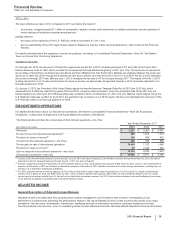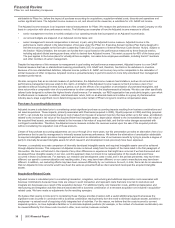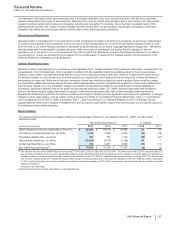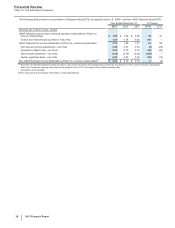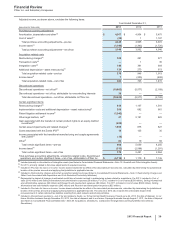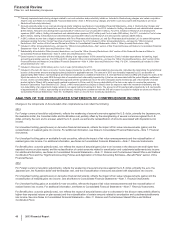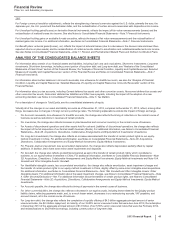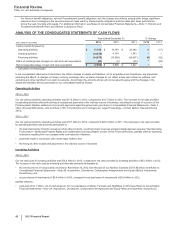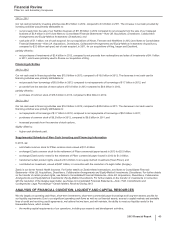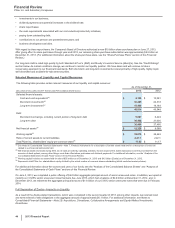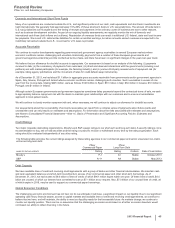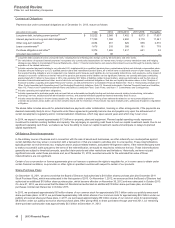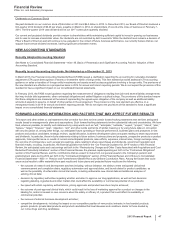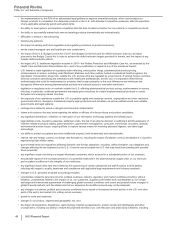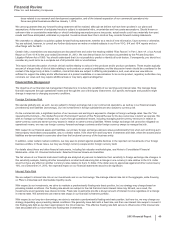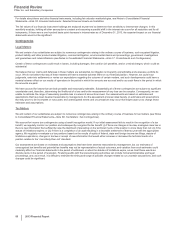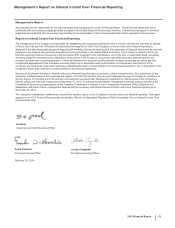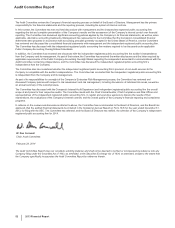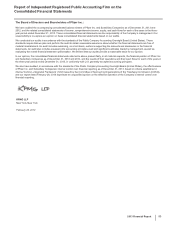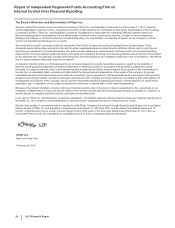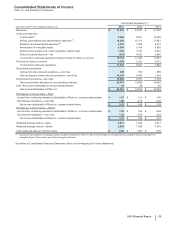Pfizer 2013 Annual Report Download - page 46
Download and view the complete annual report
Please find page 46 of the 2013 Pfizer annual report below. You can navigate through the pages in the report by either clicking on the pages listed below, or by using the keyword search tool below to find specific information within the annual report.
Financial Review
Pfizer Inc. and Subsidiary Companies
2013 Financial Report
45
Domestic and International Short-Term Funds
Many of our operations are conducted outside the U.S., and significant portions of our cash, cash equivalents and short-term investments are
held internationally. We generally hold approximately 10%-30% of these short-term funds in U.S. tax jurisdictions. The amount of funds held in
U.S. tax jurisdictions can fluctuate due to the timing of receipts and payments in the ordinary course of business and due to other reasons,
such as business-development activities. As part of our ongoing liquidity assessments, we regularly monitor the mix of domestic and
international cash flows (both inflows and outflows). Repatriation of overseas funds can result in additional U.S. federal, state and local income
tax payments. We record U.S. deferred tax liabilities for certain unremitted earnings, but when amounts earned overseas are expected to be
indefinitely reinvested outside the U.S., no accrual for U.S. taxes is provided.
Accounts Receivable
We continue to monitor developments regarding government and government agency receivables in several European markets where
economic conditions remain challenging and uncertain. Historically, payments from a number of these European governments and
government agencies extend beyond the contractual terms of sale, and there have been no significant changes in the year-over-year trend.
We believe that our allowance for doubtful accounts is appropriate. Our assessment is based on an analysis of the following: (i) payments
received to date; (ii) the consistency of payments from customers; (iii) direct and observed interactions with the governments (including court
petitions) and with market participants (for example, the factoring industry); and (iv) various third-party assessments of repayment risk (for
example, rating agency publications and the movement of rates for credit default swap instruments).
As of December 31, 2013, we had about $1.1 billion in aggregate gross accounts receivable from governments and/or government agencies in
Spain, Italy, Greece, Portugal and Ireland where economic conditions remain challenging and uncertain. Such receivables in excess of one
year from the invoice date, totaling $245 million, were as follows: $149 million in Spain; $51 million in Italy; $34 million in Greece; $10 million in
Portugal; and $1 million in Ireland.
Although certain European governments and government agencies sometimes delay payments beyond the contractual terms of sale, we seek
to appropriately balance repayment risk with the desire to maintain good relationships with our customers and to ensure a humanitarian
approach to local patient needs.
We will continue to closely monitor repayment risk and, when necessary, we will continue to adjust our allowance for doubtful accounts.
Our assessments about the recoverability of accounts receivables can result from a complex series of judgments about future events and
uncertainties and can rely heavily on estimates and assumptions. For information about the risks associated with estimates and assumptions,
see Notes to Consolidated Financial Statements––Note 1C. Basis of Presentation and Significant Accounting Policies: Estimates and
Assumptions.
Credit Ratings
Two major corporate debt-rating organizations, Moody’s and S&P, assign ratings to our short-term and long-term debt. A security rating is not a
recommendation to buy, sell or hold securities and the rating is subject to revision or withdrawal at any time by the rating organization. Each
rating should be evaluated independently of any other rating.
The following table provides the current ratings assigned by these rating agencies to our commercial paper and senior unsecured non-credit-
enhanced long-term debt:
NAME OF RATING AGENCY
Pfizer
Commercial Paper
Pfizer
Long-Term Debt
Date of Last ActionRating Rating Outlook
Moody’s P-1 A1 Stable October 2013
S&P A-1+ AA Stable May 2013
Debt Capacity
We have available lines of credit and revolving credit agreements with a group of banks and other financial intermediaries. We maintain cash
and cash equivalent balances and short-term investments in excess of our commercial paper and other short-term borrowings. As of
December 31, 2013, we had access to $8.6 billion of lines of credit, of which $961 million expire within one year. Of these lines of credit, $8.4
billion are unused, of which our lenders have committed to loan us $7.1 billion at our request. Also, $7.0 billion of our unused lines of credit, all
of which expire in 2018, may be used to support our commercial paper borrowings.
Global Economic Conditions
The challenging economic environment has not had, nor do we anticipate it will have, a significant impact on our liquidity. Due to our significant
operating cash flows, financial assets, access to capital markets and available lines of credit and revolving credit agreements, we continue to
believe that we have, and will maintain, the ability to meet our liquidity needs for the foreseeable future. As markets change, we continue to
monitor our liquidity position. There can be no assurance that the challenging economic environment or a further economic downturn would
not impact our ability to obtain financing in the future.


